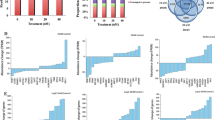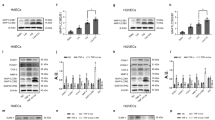Abstract
Glässer’s disease, caused by Haemophilus parasuis (H. parasuis), is associated with vascular damage and vascular inflammation in pigs. Therefore, early assessment and treatment are essential to control the inflammatory disorder. MicroRNAs have been shown to be involved in the vascular pathology. Baicalin has important pharmacological functions, including anti-inflammatory, antimicrobial and antioxidant effects. In this study, we investigated the changes of microRNAs in porcine aortic vascular endothelial cells (PAVECs) induced by H. parasuis and the effect of baicalin in this model by utilizing high-throughput sequencing. The results showed that 155 novel microRNAs and 76 differentially expressed microRNAs were identified in all samples. Subsequently, Kyoto Encyclopedia of Genes and Genomes (KEGG) pathway enrichment analysis of the target genes of the differentially expressed microRNAs demonstrated that regulation of actin cytoskeleton, focal adhesion, ECM-receptor interaction, bacterial invasion of epithelial cells, and adherens junction were the most interesting pathways after PAVECs were infected with H. parasuis. In addition, when the PAVECs were pretreated with baicalin, mismatch repair, peroxisome, oxidative phosphorylation, DNA replication, and ABC transporters were the most predominant signaling pathways. STRING analysis showed that most of the target genes of the differentially expressed microRNAs were associated with each other. The expression levels of the differentially expressed microRNAs were negatively co-regulated with their target genes’ mRNA following pretreatment with baicalin in the H. parasuis-induced PAVECs using co-expression networks analysis. This is the first report that microRNAs might have key roles in inflammatory damage of vascular tissue during H. parasuis infection. Baicalin regulated the microRNAs changes in the PAVECs following H. parasuis infection, which may represent useful novel targets to prevent or treat H. parasuis infection.






Similar content being viewed by others
References
Ye C, Li RZ, Xu L et al (2019) Effects of Baicalin on piglet monocytes involving PKC-MAPK signaling pathways induced by Haemophilus parasuis. BMC Vet Res 15:98
Rafiee M, Blackall PJ (2000) Establishment, validation and use of the Kielstein-Rapp-Gabrielson serotyping scheme for Haemophilus parasuis. Aust Vet J 78:172–174
Cai XW, Chen HC, Blackall PJ et al (2005) Serological characterization of Haemophilus parasuis isolates from China. Vet Microbiol 111:231–236
Rosner H, Kielstein P, Muller W et al (1991) Relationship between serotype, virulence and SDS-PAGE protein patterns of Haemophilus parasuis. Dtsch Tierarztl Wochenschr 98:327–330
Guo L, Guo J, Liu HS et al (2018) Tea polyphenols suppress growth and virulence-related factors of Haemophilus parasuis. J Vet Med Sci 80:1047–1053
Shen YJ, Zhou NN, An JH et al (2019) Haemophilus parasuis infection in 3D4/21 cells induces autophagy through the AMPK pathway. Cell Microbiol 21:e13031
Hua KX, Li YJ, Zhou HF et al (2018) Haemophilus parasuis infection disrupts adherens junctions and initializes EMT dependent on canonical Wnt/beta-catenin signaling pathway. Front Cell Infect Microbiol 8:324
Wen YP, Wen YP, Wen XT et al (2018) OxyR of Haemophilus parasuis is a global transcriptional regulator important in oxidative stress resistance and growth. Gene 643:107–116
He LQ, Dai K, Wen XT et al (2018) QseC mediates osmotic stress resistance and biofilm formation in Haemophilus parasuis. Front Microbiol 9:212
Wang HY, Ding Q, Wang MJ et al (2019) miR-29b inhibits the progression of multiple myeloma through downregulating FOXP1. Hematology 24:32–38
Mollaei H, Safaralizadeh R, Rostami Z (2019) MicroRNA replacement therapy in cancer. J Cell Physiol 234:12369–12384
Tili E, Michaille JJ, Piurowski V et al (2017) MicroRNAs in intestinal barrier function, inflammatory bowel disease and related cancers-their effects and therapeutic potentials. Curr Opin Pharmacol 37:142–150
Neudecker V, Yuan XY, Bowser JL et al (2017) MicroRNAs in mucosal inflammation. J Mol Med (Berlin) 95:935–949
Su W, Aloi MS, Garden GA (2016) MicroRNAs mediating CNS inflammation: Small regulators with powerful potential. Brain Behav Immun 52:1–8
Guo L, Tsai SQ, Hardison NE et al (2013) Differentially expressed microRNAs and affected biological pathways revealed by modulated modularity clustering (MMC) analysis of human preeclamptic and IUGR placentas. Placenta 34:599–605
Yang MZ, Kan L, Wu LY et al (2019) Effect of baicalin on renal function in patients with diabetic nephropathy and its therapeutic mechanism. Exp Ther Med 17:2071–2076
Huang T, Liu YN, Zhang CL (2019) Pharmacokinetics and bioavailability enhancement of baicalin: a review. Eur J Drug Metab Pharmacokinet 44:159–168
Yang XR, Zhang Q, Gao ZM et al (2018) Baicalin alleviates IL-1beta-induced inflammatory injury via down-regulating miR-126 in chondrocytes. Biomed Pharmacother 99:184–190
Wang L, Zhang R, Chen J et al (2017) Baicalin protects against TNF-alpha-induced injury by down-regulating miR-191a that targets the tight junction protein ZO-1 in IEC-6 cells. Biol Pharm Bull 40:435–443
Wu XJ, Zhi FC, Lun WJ et al (2018) Baicalin inhibits PDGF-BB-induced hepatic stellate cell proliferation, apoptosis, invasion, migration and activation via the miR-3595/ACSL4 axis. Int J Mol Med 41:1992–2002
Yue M, Yang F, Yang J et al (2009) Complete genome sequence of Haemophilus parasuis SH0165. J Bacteriol 191:1359–1360
Fu SL, Guo J, Li RZ et al (2018) Transcriptional profiling of host cell responses to virulent Haemophilus parasuis: new insights into pathogenesis. Int J Mol Sci 19:1320
Song J, Hu YJ, Jiang X et al (2018) Profiling of novel microRNAs elicited by EV71 and CA16 infection in human bronchial epithelial cells using high-throughput sequencing. Virus Res 247:111–119
Kim SH, Kang DW, Huo ZG et al (2018) Meta-analytic principal component analysis in integrative omics application. Bioinformatics 34:1321–1328
Robinson MD, McCarthy DJ, Smyth GK (2010) edgeR: a Bioconductor package for differential expression analysis of digital gene expression data. Bioinformatics 26:139–140
Blake JA, Chan J, Kishore R et al (2015) Gene ontology consortium: going forward. Nucleic Acids Res 43:D1049–1056
Minoru K, Susumu G (2000) KEGG: kyoto encyclopedia of genes and genomes. Nucleic Acids Res 28:27–30
Liu X, Wei HC, Liao S et al (2018) MicroRNA transcriptome analysis of porcine vital organ responses to immunosuppressive porcine cytomegalovirus infection. Virol J 15:16
Li HM, Xiao YJ, Min ZS et al (2019) Identification and interaction analysis of key genes and microRNAs in atopic dermatitis by bioinformatics analysis. Clin Exp Dermatol 44:257–264
Matouskova P, Hanouskova B, Skalova L (2018) MicroRNAs as potential regulators of glutathione peroxidases expression and their role in obesity and related pathologies. Int J Mol Sci 19:1199
Huang Y, Ma XY, Yang YB et al (2016) Identification and characterization of microRNAs and their target genes from Nile tilapia (Oreochromis niloticus). Z Naturforsch C 71:215–223
Taibi F, Metzinger-Le Meuth V, M'Baya-Moutoula E et al (2014) Possible involvement of microRNAs in vascular damage in experimental chronic kidney disease. Biochim Biophys Acta 1842:88–98
Wilson R, Espinosa-Diez C, Kanner N et al (2016) MicroRNA regulation of endothelial TREX1 reprograms the tumour microenvironment. Nat Commun 7:13597
Kingsley SMK, Bhat BV (2017) Role of microRNAs in sepsis. Inflamm Res 66:553–569
Jaeger A, Hadlich F, Kemper N et al (2017) MicroRNA expression profiling of porcine mammary epithelial cells after challenge with Escherichia coli in vitro. BMC Genom 18:660
Ahmadi M, Yousefi M, Abbaspour-Aghdam S et al (2019) Disturbed Th17/Treg balance, cytokines, and miRNAs in peripheral blood of patients with Behcet's disease. J Cell Physiol 234:3985–3994
Wang ZJ, Gai YD, Zhou JL et al (2019) miR-375 mediates the CRF signaling pathway to regulate catecholamine biosynthesis by targeting Sp1 in porcine adrenal gland. Stress 22:332–346
Guo J, Yang C, Zhang SX et al (2019) MiR-375 induces ROS and apoptosis in ST cells by targeting the HIGD1A gene. Gene 685:136–142
Garikipati VNS, Verma SK, Jolardarashi D et al (2017) Therapeutic inhibition of miR-375 attenuates post-myocardial infarction inflammatory response and left ventricular dysfunction via PDK-1-AKT signalling axis. Cardiovasc Res 113:938–949
Wang X, Sun H, Liao H et al (2017) MicroRNA-155-3p mediates TNF-alpha-inhibited cementoblast differentiation. J Dent Res 96:1430–1437
Mycko MP, Cichalewska M, Cwiklinska H et al (2015) miR-155-3p drives the development of autoimmune demyelination by regulation of heat shock protein 40. J Neurosci 35:16504–16515
Shao N, Ma G, Zhang JY et al (2018) miR-221-5p enhances cell proliferation and metastasis through post-transcriptional regulation of SOCS1 in human prostate cancer. BMC Urol 18:14
Fang K, Sideri A, Law IKM et al (2015) Identification of a novel substance P-neurokinin-1 receptor microRNA-221-5p inflammatory network in human colonic epithelial cells. J Cell Mol Gastroenterol Hepatol 1:503–515
Xue L, Luo SY, Ding HY et al (2019) Upregulation of miR-146a-5p is associated with increased proliferation and migration of vascular smooth muscle cells in aortic dissection. J Clin Lab Anal 33:e22843
Fu L, Fu XY, Mo J et al (2019) miR-146a-5p enhances hepatitis B virus replication through autophagy to promote aggravation of chronic hepatitis B. IUBMB Life 71:1336–1346
Huang Y, Wang QL, Cheng DD et al (2016) Adhesion and invasion of gastric mucosa epithelial cells by helicobacter pylori. Front Cell Infect Microbiol 6:159
Chakroun I, Cordero H, Mahdhi A et al (2017) Adhesion, invasion, cytotoxic effect and cytokine production in response to atypical Salmonella Typhimurium infection. Microb Pathog 106:40–49
Kurosawa M, Oda M, Domon H et al (2018) Streptococcus pyogenes CAMP factor promotes bacterial adhesion and invasion in pharyngeal epithelial cells without serum via PI3K/Akt signaling pathway. Microbes Infect 20:9–18
Liu Y, Han JK, Zhou ZY et al (2019) Paeoniflorin protects pancreatic beta cells from STZ-induced damage through inhibition of the p38 MAPK and JNK signaling pathways. Eur J Pharmacol 853:18–24
Deng Y, Liu B, Mao W et al (2019) Regulatory roles of PGE in LPS-induced tissue damage in bovine endometrial explants. Eur J Pharmacol 852:207–217
Habes QLM, Linssen V, Nooijen S et al (2017) Markers of intestinal damage and their relation to cytokine levels in cardiac surgery patients. Shock 47:709–714
Martin-Alonso A, Cohen A, Quispe-Ricalde MA et al (2018) Differentially expressed microRNAs in experimental cerebral malaria and their involvement in endocytosis, adherens junctions, FoxO and TGF-beta signalling pathways. Sci Rep 8:11277
Pirro M, Bianconi V, Paciullo F et al (2017) Lipoprotein(a) and inflammation: a dangerous duet leading to endothelial loss of integrity. Pharmacol Res 119:178–187
Al-Obaidi MMJ, Desa MNM (2018) Mechanisms of blood brain barrier disruption by different types of bacteria, and bacterial-host interactions facilitate the bacterial pathogen invading the brain. Cell Mol Neurobiol 38:1349–1368
Sato H, Coburn J, Wunder E (2017) Leptospira interrogans causes quantitative and morphological disturbances in adherens junctions and other biological groups of proteins in human endothelial cells. PLoS Negl Trop Dis 11:e0005830
Wang XF, Gao L, Xiao LL et al (2019) 12(S)-hydroxyeicosatetraenoic acid impairs vascular endothelial permeability by altering adherens junction phosphorylation levels and affecting the binding and dissociation of its components in high glucose-induced vascular injury. J Diabetes Investig 10:639–649
Xia J, Zhang HW, Gao XP et al (2016) E-cadherin-mediated contact of endothelial progenitor cells with mesenchymal stem cells through beta-catenin signaling. Cell Biol Int 40:407–418
Li ZD, Pearlman AH, Hsieh P (2016) DNA mismatch repair and the DNA damage response. DNA Repair (Amst) 38:94–101
Fransen M, Lismont C, Walton P (2017) The peroxisome-mitochondria connection: How and why? Int J Mol Sci 18:1126
Fu SL, Xu L, Li SL et al (2016) Baicalin suppresses NLRP3 inflammasome and nuclear factor-kappa B (NF-kappaB) signaling during Haemophilus parasuis infection. Vet Res 47:80
Acknowledgements
This work was supported by the National Natural Science Foundation of China (Grant No. 31572572, 31601922).
Author information
Authors and Affiliations
Contributions
Material preparation, data collection and analysis were performed by SF, JL, JX, YZ, LG, CY, YL, ZW, YH, and C-AAH. The first draft of the manuscript was written by SF and YQ. All authors commented on previous versions of the manuscript. All authors read and approved the final manuscript.
Corresponding author
Ethics declarations
Conflict of interest
The authors declare that they have no conflict of interest.
Ethical approval
This article does not contain any studies with animals performed by any of the authors.
Additional information
Publisher's Note
Springer Nature remains neutral with regard to jurisdictional claims in published maps and institutional affiliations.
Electronic supplementary material
Below is the link to the electronic supplementary material.
Rights and permissions
About this article
Cite this article
Fu, S., Liu, J., Xu, J. et al. The effect of baicalin on microRNA expression profiles in porcine aortic vascular endothelial cells infected by Haemophilus parasuis. Mol Cell Biochem 472, 45–56 (2020). https://doi.org/10.1007/s11010-020-03782-y
Received:
Accepted:
Published:
Issue Date:
DOI: https://doi.org/10.1007/s11010-020-03782-y




